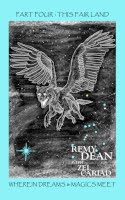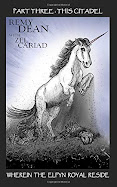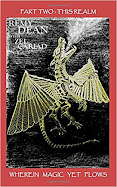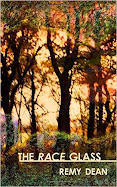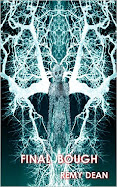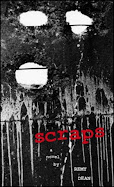Itinerary: Old Town Square, Astronomical Clock, Colloredo-Mansfeld Palace, Charles Bridge, Prague Castle Complex, Golden Lane, St Vitus Cathedral, Museum Kampa…
 |
| 'Post-Praha' by Remy Dean (photograph, 2013, Prague) |
Arriving at the Old Town Square just minutes before ten we get to see the famous, historically important Astronomical Clock strike the hour. First the reaper, whose name is death, rings a little bell (ask not), then two hatches above the gorgeous giant’s pocket-watch clock face open and a procession of the apostles trundle past, briefly pausing to bestow rickety blessings upon the modest crowd assembled below. How must that gathering have changed under their dull wooden gaze? An hour-by-hour time-lapse of five centuries… mediaeval penitents gradually transmorphing through their generations into today’s tourists with their faces hidden behind long lenses and camera-phones. Then the big bells sound across the city, meting out the time. That’s it for now… At other, more important hours, trumpeters appear at the very top of the tower and lay out a fanfare across the gothic rooftops of old Prague.
Then, just a short walk to our first destination. The
ArtBanka Museum of Young Art announced its temporary closure earlier in the year, so we were not sure what to expect. The gallery has now re-opened under the grand name of
Colloredo-Mansfeld Palace. The visit provided an experience far beyond any expectations – which is strange considering that most of the gallery was empty… the exhibition was the gallery itself. Not as ‘challenging’ and Post-Modern as it may sound when you realise that the gallery occupies a slightly dilapidated, yet spectacularly cinematic, Baroque Palace. The exterior had not really given any indication of the crumbling splendour within. The ascent up broad flights of creaking stairs takes you past little, lovely compositions created by the removal of paint and layers of thin plaster to reveal squares of original paintwork from various historic periods. They fascinated me before I realised this was the exhibition. The fantastic, filmic interiors are in the process of being restored by a team of painter-decorator archaeologists. The grandeur of the main hall with its two-storey mantelpiece and car-sized chandelier is beautifully counterpointed by the areas of floor marked out as not load-bearing, so you really have to watch your step whilst gazing up at the ceiling fresco… It felt a bit like we had stumbled across an abandoned mansion that just screamed out for a period play to be written for it, or perhaps to be a location for a some stylish, high gothic horror…
 |
| ArtBanka - the gallery is the exhibition... |
So add to this delight the surprise of ascending to the top floors and finding an exhibition of ‘bang-up-to-date’ projected video art.
Daniel Hanzlik's Sources of Signals is video art that actually makes use of its medium, not just performance art repeated on a video loop, but the way that video projectors flicker, split colours and cast shadows being used as formal elements within the installations. Even if that sort of thing is not your 'cup of tea', the situation and contrast with the lower floors is an inspiring experience in itself. This dramatic contrast set the tone for the entire visit.
Right outside the doors, the road leads across the famous ancient Charles Bridge, lined with statues of saints and imposing figures pointing the way along the slumping cobbles. The bridge presents ‘postcard’ views of the river Vltava, infested with swans and fronted by a romantic hotchpotch of gothic, baroque, rococo facades interrupted here and there with more modern buildings and bridges. Clearly visible, commanding the crest of the opposite bank, is the fairy-tale castle complex – our next destination.
The changing of the guards starts as we arrive at the main gates of the Prague castle. Smartly dressed soldiers parade through the ‘Ministry of Silly Walks’ catalogue, only they do it with impressive severity and focus, marching ceremonially to rousing bursts of brass and drumming that evoke expectations of ‘Thunderbirds’. Their precision is admirable and at the exact moment that they eventually hand over their banner, a resonant bell strikes the hour.
Inside the
Castle complex is vast and, as you might expect - complex, but you will find a helpful little map on the back of your ticket. Points of interest include the imposing St Vitus Cathedral (you don’t need any map to find that), the jousting hall, the gallery of paintings, the toy museum… and after getting some lunch in one of the castle cafes, which was a fantastic mushroom risotto, I head for Golden Lane – where once great alchemy was wrought.
Last time I had visited Prague, going on four years ago, this section of the Castle had been closed for restoration work and I had only glimpsed it from a small window in the back of the Toy Museum. That was the trip when I had befriended Sparky, my erstwhile guide for this tour – he had wanted to return to his home city for nostalgic reasons and to seek out Abby and Cynthia, two of his little friends that had shared some good times but since lost touch. So he knew his way about, and his point of view was always from a refreshingly different perspective to my own. Although he is a dog of very few words, his constant state of surprise and wonderment at the world is a lesson in itself.
 |
| L - R: tiny houses in Golden Lane, Sparky, Apothecary |
The houses in Golden Lane are definitively quaint, tiny, pastel coloured, some with knee-high fenced enclosures, window boxes and small ornate windows set in the slopes of their low roofs. Some of the houses are craft shops and some are restored to a period in the castle’s history. I gravitated to a small courtyard at the one end and found the Apothecary, set up as it would have been around the Renaissance times, with bunches of aromatic drying herbs and tiny bottles of tinctures. A little further on was an un-marked, low-lintelled and unassuming doorway… Narrow, worn, red-brick stairways led steeply up and down. A few steps up and I was in the Alchemist’s chamber.
I was overcome with awe, excitement, perhaps longing. This was once the epicentre of the occult world. Back then, the Great Work stood in proud place of Medicine and Science. The corporeal and spiritual overlapped and interacted. Philosophy and Magick guided the search for Knowledge and Wisdom. There was apparatus set up on the table, a book open on the reading stand near to the small window, a grand canopied bed and an age-darkened chair pulled close to the small fireplace. I could picture Prague’s Alchemist Royal sitting there, in deep, world-changing discussion with Doctor John Dee, the visiting envoy of Elizabeth I, Queen of the far away British Empire… but in the chamber below, down the crooked stairs, greater wonder awaited…
 |
| Golden Lane - as above, so below - the Alchemist's chambres |
The Alchemy Workshop. This could be the place. Not here and now, but here… and long ago! Where John Dee, after much preparation and procedure, was reported to have to have produced the Philosophers’ Stone before the eyes of Royal witnesses. The only time ever, in the lore of occult history, when such claims have been substantiated by independent witnesses… I have no doubt that something astonishing did happen, indeed great alchemy was wrought. A ‘transmutation of the stone’ was performed before the Royal Court of the ruling Habsburgs, and the Holy Roman Emperor Maximillian II was so impressed that he made Dee a Marshal of Bohemia. John Dee, however, was never again able to replicate those results, for it required rare powders that he could not get hold of… Yes, even ‘serious’ historians agree that something profound happened that impressed the wise and educated of the day, and whatever that something was, may well have happened here in Golden Lane… But more of that in my up-coming ‘historical’ novel,
VITRIOL…
Feeling suitably transmutated, we strolled down the length of Golden Lane, absorbing the sense of history stretching back from now to then, popping in to the more interesting houses… The Vitalis Bookshop occupies number 22, the house once owned by the sister of Franz Kafka where he often stayed and wrote, and where I purchased a beautiful little book about the Prague Golem and other Stories from the Jewish Ghetto.
 |
| Matylda Prusova's kitchen cabinet and Madame de Thebes' writing desk |
Number 14 Golden Lane has been restored to the early C20th, between the Wars, when the famous psychic, Madame de Thebes, lived there and received her clients. Matylda Prusova was known internationally and unfortunately attracted the attention of the Nazis, who were obsessed with many things epitomised by Prague – High Magick, Jewish Culture, Alechemy, Clairvoyance, Precognition… all things Occult. At a time when the ‘mighty’ Third Reich looked set to conquer all of Europe, she bravely predicted that they would fail and then fall. So, they tortured her, and because she would not change her predictions to please the elite, they murdered her.
 |
| Wonderfully cluttered with film regalia, the home of Joseph Kasda |
Joseph Kasda, a very influential art historian, lived at Number 12 after the fall of the Third Reich. A film-maker himself, he was particularly interested in cinema and almost solely responsible for the preservation of early Czech films from before this period. He was the nucleus of the Arts Society immediately after the War and used to host daily talks and screenings, with soup provided by his wife.
 |
| The impressive Prague Castle Armoury |
In the battlements above Golden Lane you will find a huge collection of Renaissance armour and weaponry, with some earlier examples dating back to C6th. The workmanship is impressive, ingenious mechanisms of death crafted with the eye of a jeweller. Precision firing mechanisms mounted on the hilts of swords, crossbow-axe-muskets, engraved demons, steel feathers and suits of armour for children… There is a terrible beauty here, if you can divorce the objects from their function, but imagining yourself as one of the wearers and wielders is chilling, rather than thrilling.
 |
| St Vitus Cathedral and the Mucha window |
This time, I cannot fit in a visit to the Toy Museum, which has a diverse collection bound to evoke nostalgia in most. It is well worth a look, but I still have strong memories from my previous visit - and some pictures...
 |
| In the Toy Museum, Prague Castle... those were the days... |
So instead, as daylight fades, I enjoy the ambience of the castle streets and then a quick visit to Mucha’s stained glass window in the vast interior of St Vitas Cathedral. The colours and figures are beautiful, vibrant yet sensitive. The deep blues seem to dominate, but are cleverly countered by yellows and oranges, making it seem brighter than the light should allow. (Later, after a visit to the Mucha Museum, I will better understand the visual language and colour theories of this Master.) The rest of the Cathedral is as hugely impressive and gothic as I recall, with many chapel chambers and monstrances of darkened glass. There is an impressive pipe organ and tall columns rising to the hazy heights of the vaulted ceiling.
The castle complex is at our highest point and commands great panoramas of the city as we leave and head back downhill towards the river, where we visit the
Museum Kampa. Situated near the Charles Bridge, you cannot miss it - it’s the one with the glowing yellow penguins filing along the jetty outside and David Cerny’s giant bronze babies in place of garden gnomes...
 |
| Sparky engages with some Czech art at the Kampa |
The
Kampa collections are a cleverly curated cross-section of Modern Czech art - a wide range of materials and styles concentrated in a modest sized arts centre. It is one of my favourite galleries, not because every piece of art is awe-inspiring, original and satisfying – they are not. I have problems engaging with some, whilst others ‘knock my socks off’. Something that stands out about modern and contemporary Czech art is that even if it is not ‘good art’, it is usually interesting and rewarding in some way. Perhaps there is a clever use of materials, an unusual treatment of form, an unexpected aesthetic fusion, something that appears derivative… until you check the date it was made (no pun intended here). There is no better place to observe and appreciate this, than the Kampa.
 |
| Don't worry, Sparky... |
After the walking, you may want to ‘sit-a-spell’ in the courtyard and enjoy the fresh, cool autumnal air coming off the river, spend a moment considering the metal and stone sculptures and statuary, before entering the spacious and calming reception. Then up to the permanent collection galleries where a good range of responses are ensured. On the walls the work ranges from collages of wood, meticulously folded surfaces of paper, rusting metal reliefs, single-colour compositions and lively-lined studies of the human form. The sculptures are varied in every aspect. There are pure cubes of milky white light, clear discs and lenses of glass, mutant, faceless figures screaming out their red existential angst, a tall man walking into a canvas carrying his own coffin, pink bombs, headless beige figures lurking in a corner, awaiting some sort of purpose or direction – Sparky eyes them suspiciously and needs to be moved on before he starts barking…
Almost as an afterthought, we pop in to see the temporary exhibition of work by Zdena Fibichova, a Czech artist whose sculptures elevate the everyday into totemic forms, ephemera into ‘archaeological’ artefacts. The lines in her drawings crackle with bright, colourful energy. Powerfully simple abstracts, in cement and ceramic are pushed to the point where they may be about to become recognisable animal forms. A ripped out page from a spiral-bound notebook is immortalised in bronze-patina clay… and nearby has been remodelled in concrete. You get a few glimpses of the exhibition in the curator's intro video above.
Night had now fallen and the open air roof terraces of the Kampa afford views of the Charles Bridge and along the river where the reflected golden lights shimmer across the water. If you are feeling brave, then the top of the stairwell has a load-bearing glass floor as its roof where you can look directly down at the ‘mobile’ that hangs through several floors of the atrium. I only managed to set foot on it in order to rescue poor Sparky, who could neither move nor bring himself to look down…
The night crossing of the Charles Bridge was moody and Romantic and soon we were back in the Old Town Square, where I remembered a fine restaurant near the astronomical clock. It had been a long day of intense stimulation and we had been on our feet for most of it. Time for some hearty Prague food! At
U Zlaté Konvice, down several flights of stairs, we dined in a vaulted cellar surrounded by stuffed bears, boars and badgers. A starter of carp fingers and smoked mackerel was followed by a big plate of smoked ham with Prague style potato pancakes, pickled cabbage and a chilli, all washed down by a hefty glass of local beer. It was a rich and satisfying meal, the ham was glossy and very smoky, the pancakes were dense and herby, the beer was strong, dark and handsome, the lively live music was a ‘cheesy’ accompaniment… the price very agreeable. Just what we needed to round off the day!
 |
| Mmm... Sparky hams it up! |
Walking back to the hotel through the night streets of Old Prague, looking up at its spired and slumped roofline, sipping warm, red, spiced wine from a plastic cup, I thought that if I were an ancient vampire, this city would certainly suit me…
 |
| Olde Prague at night... Romantic, with a capital 'R' |
Next:
A Wednesday in Prague






.jpg)
































